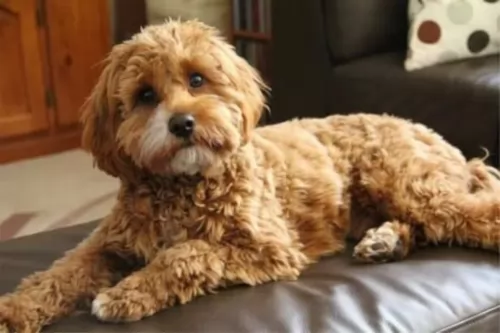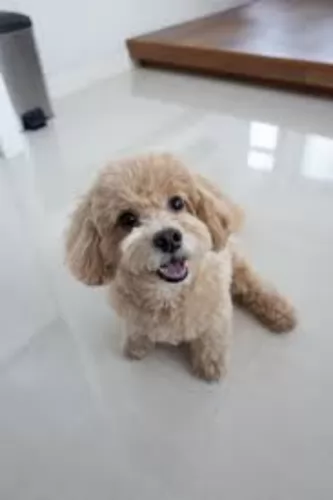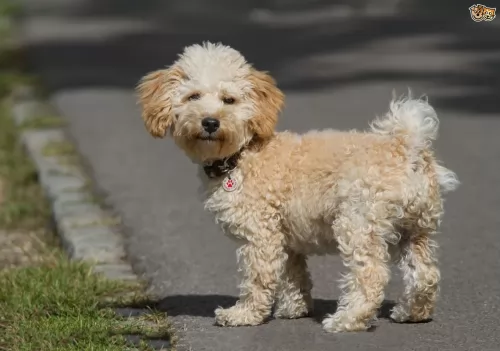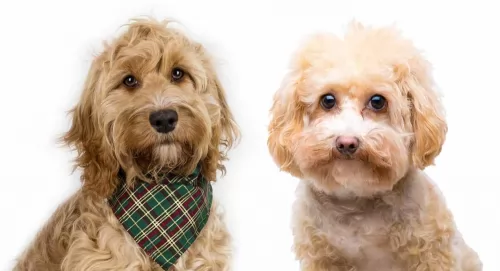 Petzlover
Petzlover Cavapoo is originated from United States but Hokkaido is originated from Japan. Cavapoo may grow 18 cm / 7 inches shorter than Hokkaido. Cavapoo may weigh 37 kg / 81 pounds lesser than Hokkaido. Both Cavapoo and Hokkaido has same life span. Both Cavapoo and Hokkaido has almost same litter size. Both Cavapoo and Hokkaido requires Moderate Maintenance.
Cavapoo is originated from United States but Hokkaido is originated from Japan. Cavapoo may grow 18 cm / 7 inches shorter than Hokkaido. Cavapoo may weigh 37 kg / 81 pounds lesser than Hokkaido. Both Cavapoo and Hokkaido has same life span. Both Cavapoo and Hokkaido has almost same litter size. Both Cavapoo and Hokkaido requires Moderate Maintenance.
 The Cavapoo, known also as the Cavoodle, is a small dog – a mix of a miniature Poodle and a Cavalier King Charles Spaniel.
The Cavapoo, known also as the Cavoodle, is a small dog – a mix of a miniature Poodle and a Cavalier King Charles Spaniel.
He hasn’t got a long history, but each of the dogs he comes from – the Cavalier King Charles Spaniel and the Poodle – have longer histories. The Cavapoo started being bred in the United States, but he has a short history in America. In Australia, they were first bred in the 1990s.
Today, as a hybrid, the Cavapoo isn’t recognized by the American Kennel Club but he is recognized by the American Canine Hybrid Club as well as the Designer Dogs KennelClub.
 The Hokkaido breed originates in Japan and is also called Ainu-ken, Ainu dog, Seta or Do-ken. The last being its common name in Japan. It is believed that the Hokkaido is descendent from the Japanese Matagi-ken, meaning hunting dog, deer hunting dog or bear hunting dog. It was the Ainu peoples that brought the breed to Tohoku. Many years later the Yayoi people brought in another breed of hunting dogs. These breeds were in isolation for most of their existence and therefore they had little influence on the further development of other breeds.
The Hokkaido breed originates in Japan and is also called Ainu-ken, Ainu dog, Seta or Do-ken. The last being its common name in Japan. It is believed that the Hokkaido is descendent from the Japanese Matagi-ken, meaning hunting dog, deer hunting dog or bear hunting dog. It was the Ainu peoples that brought the breed to Tohoku. Many years later the Yayoi people brought in another breed of hunting dogs. These breeds were in isolation for most of their existence and therefore they had little influence on the further development of other breeds.
The Ainu dog was used in searches as well as hunting and became in 1937 “a rare species in Japan that is protected by law”. At that time the Official Name of the breed was set in place as Hokkaido-Inu. But they are still called Hokkaid0-Ken by most Japanese people.
This is a very rare breed of dog. It is hardly known outside of Japan and in country there are about ten to twelve thousand remaining. Of those about nine hundred to one thousand are registered in Japan every year. It is guessed that less than thirty exist outside Japan.
The Hokkaido breed is the oldest Japanese breed of dogs. Today they are great indoor companions, loyal and friendly. Most people in Japan still call them the Ainu dog.
 The Cavapoo can be found in different colors and he can be blonde, white, brown, white or black or even tri-colored. Sometimes the coat can be a little bit curly but it can also sometimes be a long, silky coat from the Cavalier.
The Cavapoo can be found in different colors and he can be blonde, white, brown, white or black or even tri-colored. Sometimes the coat can be a little bit curly but it can also sometimes be a long, silky coat from the Cavalier.
Dogs crossed with poodles, such as the Cavapoo, are known to be hypoallergenic, but there is really no 100% guarantee that he will be hypoallergenic.He has a round face with large, brown eyes and long ears. He can adapt easily to life in the city or in the countryside.
The Cavapoo is a small dog breed that has been bred to be an amicable pet. He gets along well with adults and children as well as other pets in the home. He stands about 28–33cm in height and can weigh anything from 5 to 12 kg.
He is an intelligent little dog, alert and inquisitive. Even a small, non-aggressive dog such as the Cavapoo can do well with training and socialization as he is quick to learn. With this socialization he becomes an obedient, affectionate, well behaved 4-legged family member.
Loyal and friendly, the Cavapoo thrives on human companionship and he just loves to be involved in everything the family is getting up to. He isn’t a dog that can be left on his own too long as this is when he develops irritating behavior patterns such as ongoing yapping and barking.
 The Hokkaido breed is medium in size but very strong in build. Dogs bred outside Japan tend to be smaller. They have wide, deep chests, and long thick coats compared with Japanese dogs from other breeds. It is a double coat of long fur on top and short softer fur underneath for the second coat. Their ears are triangular and small while their eyes have a triangle outline. The double coat could be sesame, white, red, black, black and tan and wolf-gray.
The Hokkaido breed is medium in size but very strong in build. Dogs bred outside Japan tend to be smaller. They have wide, deep chests, and long thick coats compared with Japanese dogs from other breeds. It is a double coat of long fur on top and short softer fur underneath for the second coat. Their ears are triangular and small while their eyes have a triangle outline. The double coat could be sesame, white, red, black, black and tan and wolf-gray.
They are an intelligent breed with an impulsive gait. They are alert, courageous and suspicious. They were used for guarding the city gates. Their skull is flat and broad and the tongue, like the chow chow, is blueish. black. With a black nose and a wedge shaped muzzle, the Hokkaido is a handsome dog. His lips are with black and tight. High set, thick tail over the back or slightly curved to the side.
 Pet lovers who welcome a Cavapoo into their home aren’t going to be disappointed if they stick to their side of the bargain and provide their pet with lots of love and care.
Pet lovers who welcome a Cavapoo into their home aren’t going to be disappointed if they stick to their side of the bargain and provide their pet with lots of love and care.
The Cavapoo suits any kind of family because he is playful, loving, loyal and comes with a balanced and amicable personality.
Keep him happy with good food, clean water and lots of your attention and he’ll respond by being the perfect companion for you.
 The Cavapoo is considered a healthy little dog who is active and energetic. Because he is a hybrid, he could develop illnesses associated with either of the dog types he comes from. However this is highly unlikely and you can expect up to 15 years from your Cavapoo if you feed him correctly and shower him with lots of love and attention.
The Cavapoo is considered a healthy little dog who is active and energetic. Because he is a hybrid, he could develop illnesses associated with either of the dog types he comes from. However this is highly unlikely and you can expect up to 15 years from your Cavapoo if you feed him correctly and shower him with lots of love and attention.
Dogs with long, floppy ears tend to be more prone to ear infections. You’ll have cause for concern when you see your dog scratching his ears or shaking his head. There are one or two reasons why your Cavapoo may get an ear infection, and food allergies could be one.
A food allergy can bring about inflammation that can lead to infections. Moisture and excessive wax can also cause an ear infection. You can use cotton wool and some ear cleaner to remove dirt and moisture, but if in any doubt, speak to your vet or get your pet to the vet for advice.
Small dogs are more prone to dental disease, and your Cavapoo’s teeth should be brushed 2 or 3 times a week with a vet-approved special dog toothpaste and brush. This can prevent dental decay which can bring about a whole lot of problems with his teeth but also with other parts of the body.
 Often breeds that are isolated like the Hokkaido, have a pretty good health history but there are a few serious issues that they face.
Often breeds that are isolated like the Hokkaido, have a pretty good health history but there are a few serious issues that they face.
1/3 of all dogs have it while 2/3 are carriers. This disease is congenital and there is no cure. It affects the sclera, retina and choroid. It can be mild or it can cause blindness.
Affecting joints and cause arthritis and lameness.
Floating kneecap – not as prevalent here as in smaller dogs.
Could be mild or serious. Could require a pacemaker.
Seizures of an unknown origin. Can be treated with medication not cured.
Excessive, uncontrollable urge to drink large amounts of fluid without a stimuli.
 The Cavapoo doesn’t shed much so he won’t need that much grooming, although there are people who take him to a doggy parlor to see that the hair is trimmed into shape. If not, then a good brushing twice a week will ensure the hair doesn’t matt and that it remains free of lots of dead hair.
The Cavapoo doesn’t shed much so he won’t need that much grooming, although there are people who take him to a doggy parlor to see that the hair is trimmed into shape. If not, then a good brushing twice a week will ensure the hair doesn’t matt and that it remains free of lots of dead hair.
With any dog, and not just the Cavapoo, you want a food that boosts energy and promotes longevity. The Cavapoo breed is energetic and lively, and it is this stamina of his that will require you feeding him top quality food that is rich in nutrients.
Small dogs have a higher calorie need than large dogs because their metabolisms are much faster. Protein and fat are important nutrients for small-breed dogs and these nutrients need to come from high-quality sources. Speak to your vet about the best food for your Cavapoo and always ensure that he has a bowl of clean water available.
 The puppy needs about 300 -400 calories per day in 3-4 servings per day
The puppy needs about 300 -400 calories per day in 3-4 servings per day
The adult dog needs about 250-350 calories a day to maintain good weight and health. Feed 2-3 times per day.
Strong, stamina
These dogs love exercise and definitely need it. They will get to be anxious or bored if they don’t get enough exercise. A back yard run is fine but remember that the Hokkaido is a jumper and make sure your fence is at least six feet high. They need daily walks even if you have a fenced yard. Martindale collars or harnesses are needed when walking them.
These dogs love games and competitive activities. They are good at hunting and guarding of course. There are other activities they can excel at and enjoy jogging, biking with you, and hiking. In competition they enjoy and are good at agility, flyball, lure coursing, rally, weight pull, dock diving, and obedience. They do not participate in confirmation.